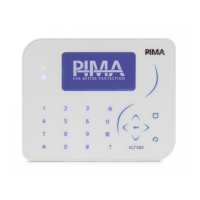Force Security System - Installation Guide
34
2) Kissoff Wait: how long to wait for a Kissoff message, before
resending the report. Change only if necessary, for example if there are
delays in the communication. Range: 1-5000 milliseconds.
3) ACK Frequency: select between Lo-Hi, 1400, 2300, and SIA.
Set a time of the day to send a test report to the CMS. This report is sent in
addition to the test report interval (next).
Set an interval in hours to send a test report to the CMS. This report is sent
in addition to the periodic test report.
Set the number of dials and redials that if fail (no ACK is received), a
communication fault is reported.
Select if the telephone is the primary path for reporting the CMS.
4) GSM-Voice: see the Telephone (PSTN) menu above.
5) Network (Ethernet): in addition to the above Telephone (PSTN) parameters, the network
has the following:
IP/URL 1-2: enter up to two IP addresses of the CMS, or a URL (web
address).
Port 1-2: enter the port no.
Set supervision (test) report interval. The report
is designated to the IP receiver at the CMS.
0 (not reporting)-
59:59 mm:ss
6) GPRS-IP: see Network (Ethernet) above.
Event Reporting
System Configuration
CMS & Communications
Monitoring Stations
CMS 1-2
Event Reporting
Select the events to report to the CMS (e.g. Burglary Alarm, Tamper Alarm, Invalid Code).
8.1.2 Radio
System Configuration
CMS & Communications
Monitoring Stations
Radio
See section 8.1.1 above for details on the parameters, except those on the next table:
Set the radio format. Obtain it from the CMS.
Set the number of transmissions and retransmissions
per report.
Set the number of frames per single transmission.
Reporting Codes
Set the radio reporting codes for alarms and other events, as well as the restore codes. Note
the following:
1. The codes apply only for some radio protocols. Consult the CMS before setting them.
2. A zone is restored in the following conditions:
a. The alarm system/partition is disarmed (or the first partition, if the zone is allocated to
more than one).

